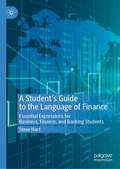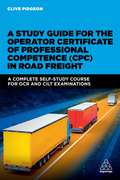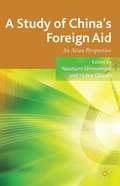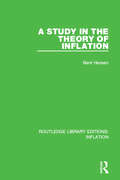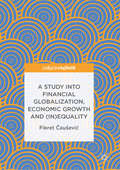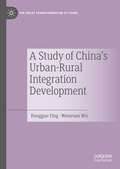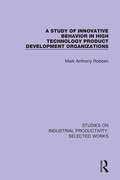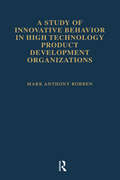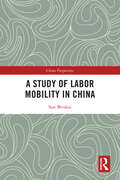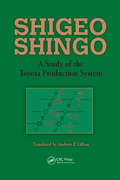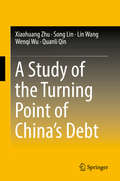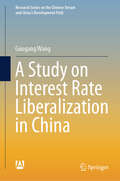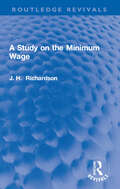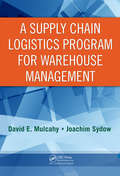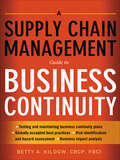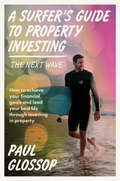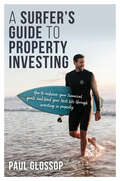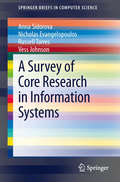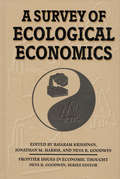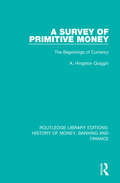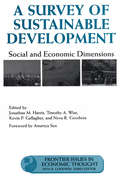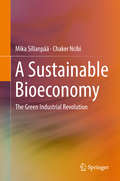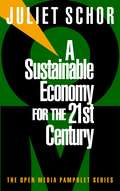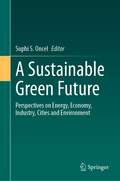- Table View
- List View
A Student’s Guide to the Language of Finance: Essential Expressions for Business, Finance, and Banking Students
by Steve HartThis book focuses on improving reading comprehension by targeting the jargon, idiomatic language and academic expressions used in the business world. A Student’s Guide to the Language of Finance is a reference textbook designed to unlock the jargon of the business and finance world for international students, improving the reading comprehension and writing skill of English language learners by targeting the jargon, idiomatic language, and academic expressions employed in the business, finance, and banking fields. Covering terms not always captured in business dictionaries or workbooks, the resource also contains sections on spoken business English, key academic terms found in textbooks and journals and useful expressions to employ when writing an academic paper. It is specifically targeted at students whose first language is not English.
A Study Guide for the Operator Certificate of Professional Competence (CPC) in Road Freight: A Complete Self-study Course for OCR and CILT Examinations
by Clive PidgeonA Study Guide for the Operator Certificate of Professional Competence (CPC) in Road Freight is a vital study guide that offers the thorough preparation needed to pass the tough CRC exams. This is the Level 3 standard qualification overseen by OFQUAL and the Welsh Assembly Government which is required by any person wishing to operate vehicles over 3,500kgs maximum authorised mass for hire and reward, both nationally and/or internationally. A Study Guide for the Operator Certificate of Professional Competence (CPC) in Road Freight covers the examination method used by both OCR and CILT. It covers the 8 study sections that the directive requires: civil law; commercial law; social law; fiscal law; business; financial; management of the undertaking access to the market; technical standards and technical aspects of the operation road safety.The new book has been extensively revised to make it more accessible and understandable. It features many more case studies, examples, diagrams and graphics. There are also test questions for each section.
A Study Of China’s Foreign Aid
by Yasutami Shimomura Hideo OhashiThis book provides a new perspective of China's controversial foreign aid strategy. The chapters offer a thorough examination of data to show how China has created knowledge in its long experiences of aid and how this accumulated knowledge could contribute to other developing countries. The book also examines China's aid philosophy and strategy through an Asian perspective, instead of the Western perspective that is postulated in existing academic literature. This is important as China shares a number of common features with other Asian donors, including India and Japan. Finally, the book explores how to utilize the potential effect of this rising major donor for worldwide development and poverty reduction.
A Study in the Theory of Inflation (Routledge Library Editions: Inflation)
by Bent HansenThis book, originally published in 1951, is a theoretical study inspired by some central economic problems which have appeared during and after the Second World War in many countries, including Scandinavia. It develops a monetary theory for repressed inflation, gives a number of definitions and concepts and explains the connection between the concepts. The investigation of the problems of repressed inflatin also serve as an introduction to the study of open inflation.
A Study into Financial Globalization, Economic Growth and (In)Equality
by Fikret ČauševićThis book focuses on the impact of financial liberalisation and globalisation on economic growth and inequality worldwide over the past quarter century. It places a particular emphasis on the first fourteen years of this century. It begins by exploring certain assumptions developed as a result of early works in the field, providing a critical review of some of the most important academic works published over the past twenty years. It then goes on to present a comparative measurement of the economic performance of key countries for which data is available in the World Bank database, including G-10 countries, EU countries, and fastest growing countries like China, India, and small-open oil-producing economies.
A Study of China's Urban-Rural Integration Development (The Great Transformation of China)
by Wenyuan Wu Dangguo YingChina's urbanization has stunned the world in the past two decades- but as the authors of this book explain, the growth is only set to continue. The divide between urban and rural citizens in China implicates every aspect of Chinese life, from education to pollution to healthcare. In this book, one of China's most celebrated academic urbanists and a major urban planner collaborate in laying out and analyzing the problems of China's urban-rural divide, experiences of urbanization, and what the future holds. This book is a must read, not only for the accurate summaries of China's developmental experience it includes, but also for the insights it provides into the mentalities of the government officials and private developers who are creating realities on the ground in Chinese cities.
A Study of Innovative Behavior in High Technology Product Development Organizations: In High Technology Product Development Organizations (Studies on Industrial Productivity: Selected Works #6)
by Mark Anthony RobbenOriginally published in 1999, this volume integrates several streams of research on the antecedents of innovation to test a model of individual innovative behavior in a high technology product development organization. The sample for this research was a group of Engineers, Designers and Lab Technicians employed in an engineering department responsible for the development of high technology products. Structural equation modeling techniques and multiple linear regression were used to evaluate the research.
A Study of Innovative Behavior: In High Technology Product Development Organizations (Studies on Industrial Productivity: Selected Works #6)
by Mark Anthony RobbenFirst published in 1999. This study integrated several streams of research on the antecedents of innovation to test a model of individual innovative behavior in a high technology product development organization. The world we live in today is a globally competitive environment of rapidly changing technologies. Organizations must harness the innovative potential of their employees to create better and novel ways to solve old and new problems or risk becoming extinct. Innovative organizations can gain a competitive advantage over their less innovative competition through better products, faster product development times, and lower priced products.The research sample used in this study contained Product Engineers, Application Engineers, Lab Technicians, and Product Designers in an Engineering Department responsible for the development of high technology products. Various survey instruments were used to measure individual problem solving style, leader-member exchange, role expectation, and work climate. The Kirton Adaption-Innovation (KAI) inventory, which is used in many countries, was used to evaluate problem solving style. The KAI score is the summation of the three sub-factors, sufficiency versus proliferation of originality, preference for efficiency, and rule/group conformity. In previous use of the KAI in the general population respondents scored consistently high or low in each of the three KAI sub-groups. In this study, innovative people in the high technology product development organization did not follow this general population trend. Unlike previous KAI studies the innovative people indicated a preference for efficiency. This makes intuitive sense in that to be innovative in a complex high technology environment an individual must have a preference toward efficiency to keep the complex information organized. As the complexity of information required in a high technology product development organization increases so must the complexity of innovative people increase.(D.B.A. dissertation, 1998; revised with new preface and index)
A Study of Labor Mobility in China (China Perspectives)
by Sun WenkaiThe title investigates rural labor mobility in China since 2003, an important phenomenon in the process of Chinese economic transition, influential in economic growth at the macro level and individual wellbeing at the micro level.Based on empirical analysis, the study identifies and evaluates the characteristics, driving forces and impact of the migration and mobility of the rural labor force. The following factors are considered to impact rural workers' mobility decisions and are thoroughly discussed in each chapter: (1) convergence in the level of regional income, (2) industrial structure and the age structure of the workforce, (3) the household registration system, (4) the income gap, (5) the issue of children that are left behind, (6) the health status of rural migrant workers and (7) their social networks. Drawing on new research methods, the final chapter reassesses the impact of rural parents' migration to the city and the overall wellbeing of their children left behind at home, challenging the well-accepted view that there is a negative correlation between the two.The book will appeal to scholars and students interested in labor economics, Chinese economy, sociology, demography, migrant population and especially labor mobility in China.
A Study of the Toyota Production System: From an Industrial Engineering Viewpoint
by Shigeo ShingoThis is the "green book" that started it all -- the first book in English on JIT, written from the engineer's viewpoint. When Omark Industries bought 500 copies and studied it companywide, Omark became the American pioneer in JIT.Here is Dr. Shingo's classic industrial engineering rationale for the priority of process-based over operational improvements in manufacturing. He explains the basic mechanisms of the Toyota production system, examines production as a functional network of processes and operations, and then discusses the mechanism necessary to make JIT possible in any manufacturing plant. Provides original source material on Just-ln-Time Demonstrates new ways to think about profit, inventory, waste, and productivity Explains the principles of leveling, standard work procedures, multi-machine handling, supplier relations, and much more If you are a serious student of manufacturing, you will benefit greatly from reading this primary resource on the powerful fundamentals of JIT.
A Study of the Turning Point of China’s Debt
by Lin Wang Xiaohuang Zhu Song Lin Wenqi Wu Quanli QinThis book proposes a method for calculating China’s debt based on a quantitative econometric analysis. This is conducted by measuring the relationship between China’s debt size and economic growth. The conclusion that is reached is as follows: China’s current debt has already exceeded the inflection point, and that means that it is now having an adverse effect on its economic performance.The book also focuses on China's debt problems as a whole, highlighting debt issues faced by different entities and industries, as well as the ratio and structure of the virtual and real economies. The contents are presented in three major principles: theory, oriented,data, and oriented policy.
A Study on Interest Rate Liberalization in China (Research Series on the Chinese Dream and China’s Development Path)
by Guogang WangThis book explores the relationship between interest rate liberalization and the reform of China's financial system. It covers many important topics about China's financial system including the role of deposit and lending rates, yields to investment, the relationship between investment and real interest rates, the impact of interest rate liberalization on resident saving, mechanism for RMB exchange rate determination, and policies necessary for interest liberalization. The book also discusses key impediments, path choice, and policy recommendations for China's interest rate liberalization.
A Study on the Minimum Wage (Routledge Revivals)
by J. Henry RichardsonFirst Published in 1927, A Study on the Minimum Wage contains constructive proposals regarding the essential features of a satisfactory minimum wage system. Based on a comprehensive international study of existing legislation and practice in the 1920s, it brings crucial themes like objects of minimum wage legislation; the living wage; provisions for the worker’s family; relation between the wages of men and women; machinery for fixing minimum wages; methods of enforcement; and the capacity of industry to pay. Rich in archival resources, this book is an essential read for students and researchers of labour history, labour economics, and political economy in general.
A Supply Chain Logistics Program for Warehouse Management
by David E. Mulcahy Joachim SydowA well-planned, well-structured warehouse management system (WMS) offers significant advantages to an organization, particularly in its ability to make warehouse operations more efficient, more cost effective, and more responsive.A Supply Chain Logistics Program for Warehouse Management details the concepts, applications, and practices n
A Supply Chain Management Guide to Business Continuity: Guide To Business Continuity
by Betty A. KildowA well-monitored supply chain is any business&’s key to productivity and profit. But each link in that chain is its own entity, subject to its own ups, downs, and business realities. If one falters, every other link—and the entire chain—becomes vulnerable. Kildow&’s book identifies the different phases of business continuity program development and maintenance, including: • Recognizing and mitigating potential threats, risks, and hazards • Evaluating and selecting suppliers, contractors, and service providers • Developing, testing, documenting, and maintaining business continuity plans • Following globally accepted best practices • Analyzing the potential business impact of supply chain disruptions Filled with powerful assessment tools, detailed disaster-preparedness checklists and scenarios, and instructive case studies in supply chain reliability, A Supply Chain Management Guide to Business Continuity is a crucial resource in the long-term stability of any business.
A Surfer's Guide to Property Investing – The Next Wave: How to achieve your financial goals and lead your best life through investing in property
by Paul Glossop‘ Whether you surf or not, Paul' s story as a property investor turned property professional is a great read. Draw on his story as you shape your own journey through property. If you' re willing to do the hard work – and embrace the journey – you' ll find your perfect wave.' – Phil Tarrant, Managing Director, Momentum MediaInvesting is about more than dollars and cents. It' s about the lifestyle it canbring – less time at work, earlier retirement, more time with friends and family,and more time at the beach.Property investing continues to be a resilient asset class that can bring substantial capital growth and a passive income – even after a global pandemic and with increased costs of borrowing.It doesn' t need to be complicated; you just need to know how to go about it.A Surfer' s Guide to Property Investing will teach you about:• mastering the investor mindset• budgeting and strategy• picking a location• understanding investment options, including renovating, house and land,and commercial property• the secret to building long-term wealth.
A Surfer's Guide to Property Investing: How to achieve your financial goals and lead your best life through investing in property
by Paul GlossopA Surfer's Guide to Property Investing is about how to achieve your financial goals and lead your best life through investing in property.Paul Glossop believes the mark of financial success isn't about getting bigger, better, faster or more. To him, success is freedom - freedom to spend more time with his family, or giving back to his community, or just more time to go surfing.Paul initially studied architecture before transferring his focus to education. He started working as a teacher in one of the roughest, toughest schools in the UK. A series of fortunate events brought him back to Sydney where over 10 years investing in property, Paul amassed a portfolio which has been focused on capital growth, development opportunities and cash flow. The success of his portfolio gave Paul the financial freedom to take a calculated risk to walk away from a successful corporate career and start something that he was truly passionate about: helping his family and others change their lives through investing in property.
A Survey of Core Research in Information Systems (SpringerBriefs in Computer Science)
by Anna Sidorova Nicholas Evangelopoulos Russell Torres Vess JohnsonThe Information Systems (IS) discipline was founded on the intersection of computer science and organizational sciences, and produced a rich body of research on topics ranging from database design and the strategic role of IT to website design and online consumer behavior. In this book, the authors provide an introduction to the discipline, its development, and the structure of IS research, at a level that is appropriate for emerging and current IS scholars. Guided by a bibliometric study of all research articles published in eight premier IS research journals over a 20-year period, the authors identify and present the top 51 IS research topics. For each topic, they provide a brief overview, time trends, and references to related influential research works. The topics are organized into an IS research framework that includes research on the IT artifact and IS development, IT and organizations, IT and individuals, IT and markets, and IT for teamwork and collaboration.
A Survey of Ecological Economics (Frontier Issues in Economic Thought #1)
by Jonathan Harris Neva R. Goodwin Rajaram KrishnanThe emergent discipline of ecological economics is based on the idea that the world's economies are a function of the earth's ecosystems -- an idea that radically reverses the world view of neoclassical economics. A Survey of Ecological Economics provides the first overview of this new field, and a comprehensive and systematic survey of its critical literature.The editors of the volume summarize ninety-five seminal articles, selected through an exhaustive survey, that advance the field of ecological economics and represent the best thinking to date in the area. Each two- to three-page summary is far more comprehensive than a typical abstract, and presents both the topics covered in each paper and the most important arguments made about each topic. Sections cover: historical perspective definition, scope, and interdisciplinary issues theoretical frameworks and techniques energy and resource flow analysis accounting and evaluation North-South/international issues ethical/social/institutional issues Each section is preceded by an introductory essay that outlines the current state of knowledge in the field and proposes a research agenda for the future. A Survey of Ecological Economics is the first volume in the Frontier Issues in Economic Thought series produced by the Global Development And Environment Institute at Tufts University.
A Survey of Primitive Money: The Beginnings of Currency (Routledge Library Editions: History of Money, Banking and Finance #1)
by A. Hingston QuigginThis book, first published in 1949, is the original and key survey of the stages which preceded the use of coins as the medium of exchange, and of the objects that coins displaced, objects which for want of a better name are here called primitive money. It examines in detail the primitive monies of the world, monies from far in the distant past, and monies still in use today. It is the essential reference source on the many different objects used as currency.
A Survey of Sustainable Development: Social And Economic Dimensions (Frontier Issues in Economic Thought #6)
by Amartya Sen Kevin Gallagher Jonathan Harris Neva R. Goodwin Timothy WisePerpetual economic growth is physically impossible on a planet with finite resources. Many concerned with humanity's future have focused on the concept of "sustainable development" as an alternative. Sustainable development brings together elements of economics, public policy, sociology, ecology, resource management, and other related areas, and while the term has become quite popular, it is rarely defined, and even less often is it understood. A Survey of Sustainable Development addresses that problem by bringing together in a single volume the most important works on sustainable human and economic development. It offers a broad overview of the subject, and gives the reader a quick and thorough guide to this highly diffuse topic. The volume offers ten sections on topics including: economic and social dimensions of sustainable development, the North/South balance, population and the demographic transition, agriculture and renewable resources, energy and materials use, globalization and corporate responsibility, and local and national strategies.Each section is introduced with an essay by one of the volume editors that provides an overview of the subject and a summary of the mainstream literature, followed by two- to three-page abstracts of the most important articles or book chapters on the topic.A Survey of Sustainable Development is the sixth and final volume in the Frontier Issues of Economic Thought series produced by the Global Development And Environment Institute at Tufts University. Each book brings together the most important articles and book chapters in a "frontier" area of economics where important new work is being done but has not yet been incorporated into the mainstream of economic study. The book is an essential reference for students and scholars concerned with economics, environmental studies, public policy and administration, international development, and a broad range of related fields.
A Sustainability Challenge
by Committee on Food Security for All as a Sustainability ChallengeThe National Research Council's Science and Technology for Sustainability Program hosted two workshops in 2011 addressing the sustainability challenges associated with food security for all. The first workshop, Measuring Food Insecurity and Assessing the Sustainability of Global Food Systems, explored the availability and quality of commonly used indicators for food security and malnutrition; poverty; and natural resources and agricultural productivity. It was organized around the three broad dimensions of sustainable food security: (1) availability, (2) access, and (3) utilization. The workshop reviewed the existing data to encourage action and identify knowledge gaps. The second workshop, Exploring Sustainable Solutions for Increasing Global Food Supplies, focused specifically on assuring the availability of adequate food supplies. How can food production be increased to meet the needs of a population expected to reach over 9 billion by 2050? Workshop objectives included identifying the major challenges and opportunities associated with achieving sustainable food security and identifying needed policy, science, and governance interventions. Workshop participants discussed long term natural resource constraints, specifically water, land and forests, soils, biodiversity and fisheries. They also examined the role of knowledge, technology, modern production practices, and infrastructure in supporting expanded agricultural production and the significant risks to future productivity posed by climate change. This is a report of two workshops.
A Sustainable Bioeconomy: The Green Industrial Revolution
by Mika Sillanpää Chaker NcibiAn authoritative and comprehensive volume of knowledge and green technologies wholly focused on the future of the bioeconomy. The authors present data, show opportunities, discuss R&D findings, analyze strategies, assess the wider economic impact, showcase achievements, criticize policies and propose solutions for the green revolution in biofuels, biochemicals and biomaterials' production and power generation. A fascinating range of case studies from the US, China and many European countries are used to inform readers about the impact of this field on society and how various technologies are currently being implemented. Additionally, the role of industry on this green industrial revolution is outlined with contributions from several major companies such as DuPont (US), UPM-Kymmene Oy (Finland), Anhui BBCA Biochemical Co (China).
A Sustainable Economy for the 21st Century (Open Media Series)
by Juliet SchorIn this groundbreaking pamphlet, Juliet Schor, author of The Overworked American, examines how Americans can begin making the shift away from a resource-destructive society to one that values the environment, community, and quality of life above business and profit. She a traces back how after W.W.II, Americans had hoped that technology and social investment would yield shorter work weeks, more pay, and complete healthcare. Instead, we work more, get paid less, and maintain an indecent adult minimum wage. Where did we go wrong?Schor's pamphlet charts an economic vision based that aims to reduce work hours, increase leisure, create new work schedules that are not operating on a "male" model of employment, create green quotas and industry-wide environmental standards, alternative housing and transportation, raise minimum wage, restructure labor relations, change corporate culture, and promote social accountability. The pamphlet "sets the guideposts," writes Noam Chomsky, "for constructive thinking and action to save our country from becoming a plaything for investors and transnational corporations, and to place its fate in the hands of its citizens."
A Sustainable Green Future: Perspectives on Energy, Economy, Industry, Cities and Environment
by Suphi S. OncelThe aim of this book is to open a vision to sustainability and development through a holistic perspective comprising the critical blocks of energy, environment and economy. From renewable energy, urban infrastructure, societal health to industrial symbiosis, the book assesses critical issues to reach a green future with realistic solutions proposed by a diverse range of multidisciplinary experts. It is intended for a broad readership of academics, researchers and industry experts focusing on these fields, and with specializations in sustainability. The book is divided into different clusters starting with an introductory foreword to express the theme of the book and the route of the titles. The first cluster of the book highlights various multidisciplinary perspectives considering the interaction between different expertise. From engineering to economy supported with social pillars, this section gives the critical points of selected topics to focus on the future with a sustainability vision. The second cluster focuses on health issues, with discussion about the impacts of the COVID-19 pandemic and the way forward. Critical points like vaccines, health care and food security are highlighted. The third cluster is comprised of titles related to the urban environment and infrastructure. New solutions and discussions on biodesign, waste management and transportation are covered in this section. The last cluster covers energy, and highlights renewable energies such as bioethanol, biogas and wind.
